With Councillors supporting a new pedestrian mobility plan, let's take a look at some recent pedestrian improvements the city has already made.
By Ryan McGreal
Published November 07, 2013
this article has been updated
Yesterday, the General Issues Committee received and endorsed a mammoth 244-page Pedestrian Mobility Plan. Please read the excellent two-part summary of the plan by Sara Mayo: Part 1, Part 2.
Astonishingly, west mountain Councillor Terry Whitehead spoke against the plan: "It's important that any decisions the city makes don't add to commuting time for motorists. The challenge for my constituents is gridlock." Yet even Councillor Whitehead voted in favour of it.
Indeed, Councillors seem to be more or less united in agreeing that Hamilton streets should be safer for the most vulnerable people using them - pedestrians, and especially children and senior citizens. (Of the past six pedestrians killed in Hamilton, five of them were seniors.)
With the recent report that Hamilton is one of the most dangerous cities in Ontario for pedestrians and cyclists, the City has its work cut out for it. The good news is that city staff already started making long-awaited improvements earlier this year.
After a series of tactical urbanism activities in May and a city crackdown galvanized public support for a stronger commitment to safe streets, the City Manager's office pressured the Public Works Department to see the tactical urbanism campaign as an opportunity to engage citizens and make incremental improvements.
Almost immediately, Public Works started to ramp up its intersection repair at locations across the city.
Capital budget money was made available for pilot projects to paint zebra crossings, create bumpouts and install knockdown sticks to slow traffic and improve pedestrian safety at under-served and high-risk intersections.
Bumpouts improve pedestrian safety in four specific ways:
The City's intersection repair work continues with several recent projects. Thanks to the intrepid Jason Leach, we have a bunch of photographs to share.
St. Peter's Hospital and Adelaide Hoodless School sit across from each other on Maplewood Avenue a few blocks west of Gage Park. They now have a safer walkway between them, thanks to painted bumpouts and knockdown sticks:
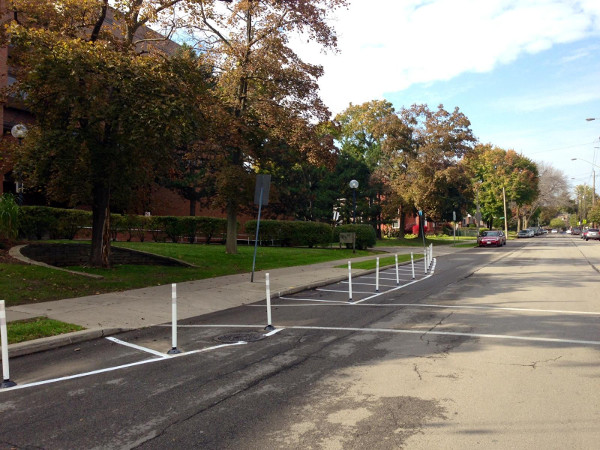
Bumpouts and knockdown sticks on Maplewood Avenue
Bay Street South is two-and-a-half lanes of speeding one-way traffic with narrow sidewalks right next to the street, and children have to brave it every day on their way to and from Central School at Bay and Hunter.
This week, City staff painted over the extra half-lane on the east side of Bay around Bold Street, adding knockdown sticks to provide a physical barrier for pedestrians.
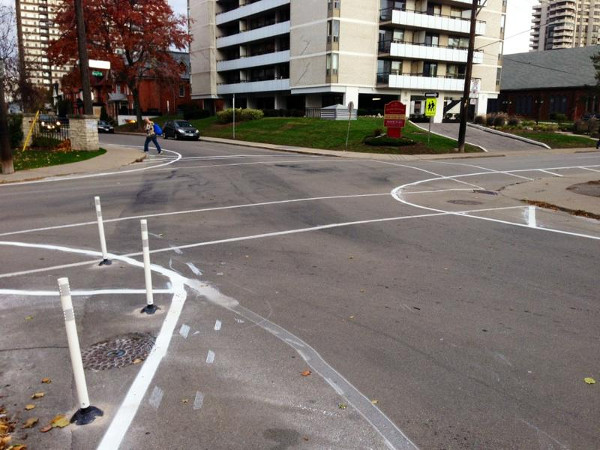
Bumpouts on Bold at Bay
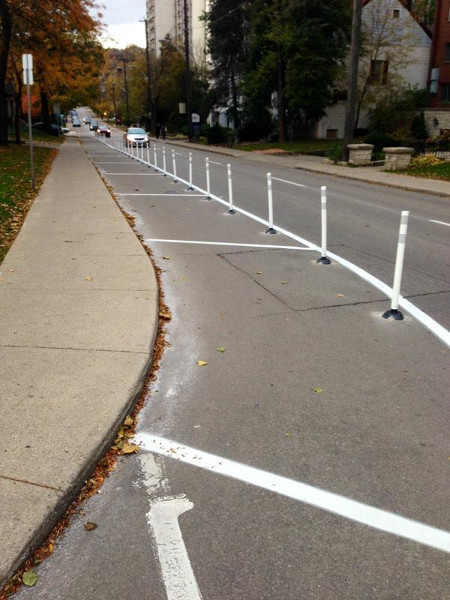
Knockdown sticks on Bay south of Bold
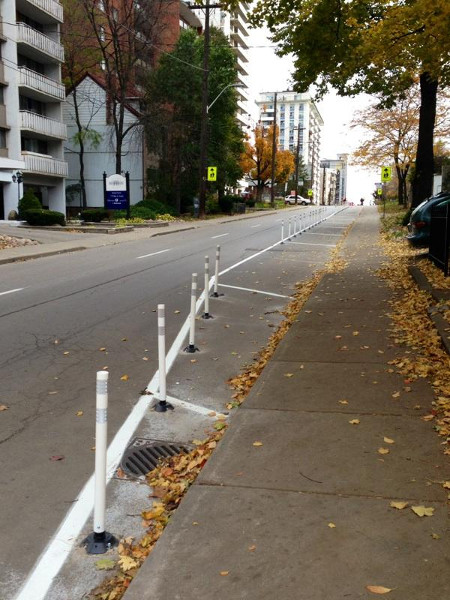
Knockdown sticks on Bay north of Bold
Westbound traffic races down the one-way Charlton Avenue West past the HAAA Park, which includes a playground, track, football field and Ryerson School.
Building on the success of speed humps on nearby Stanley Avenue, city staff have also installed speed humps on Charlton between Queen and Kent, and between Kent and Locke.
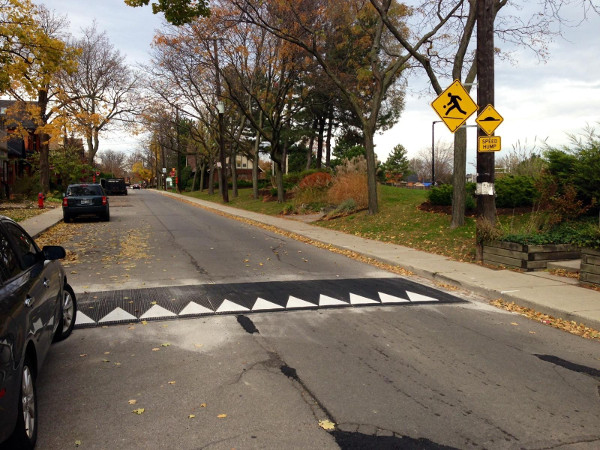
Speed hump on Charlton
The nice thing is that there is enough room to the right of the speed hump for a cyclist to pass it without catching air.
This summer, staff painted zebra crossings on Cannon at Elgin, Smith and Wentworth, to varying levels of success (the crosswalk at Smith is uncontrolled, which means most drivers don't think they have to stop for pedestrians. (The bizarre staff proposal to put up signs telling pedestrians that vehicles are not required to stop won't help.)
Now staff have also painted zebra crossings on Cannon at Barnesdale, an intersection that is controlled with traffic lights.
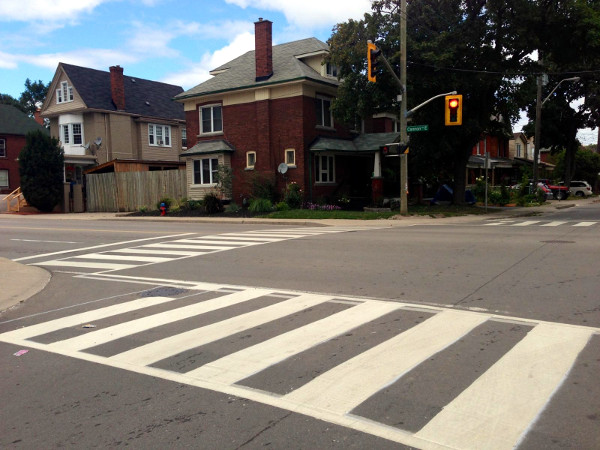
Zebra crossing, Cannon and Barnesdale
One of the tactical urbanism locations was the Delta, where Main Street and King Street meet up and the highway-style intersection makes pedestrians feel decidedly unwelcome. Staff have helped by installing knockdown sticks near the curb and painting zebra crossings:

Zebra crossings and knockdown sticks at the Delta
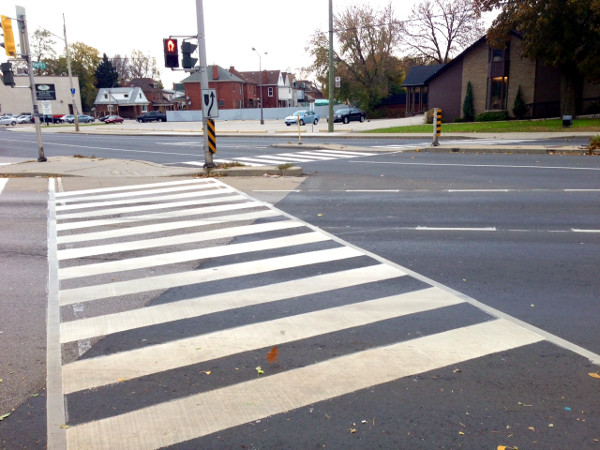
Zebra crossing closeup

Look, a pedestrian!
Staff have also been painting zebra crossings at some of the more frightening intersections on the mountain, where Mohawk Road crosses the major north-south arterials.
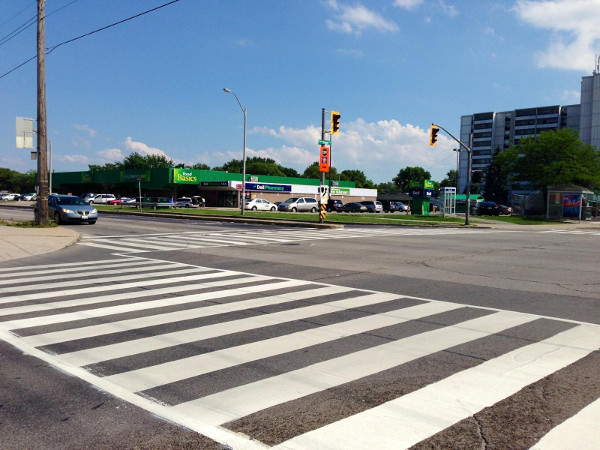
Mohawk and Upper Gage
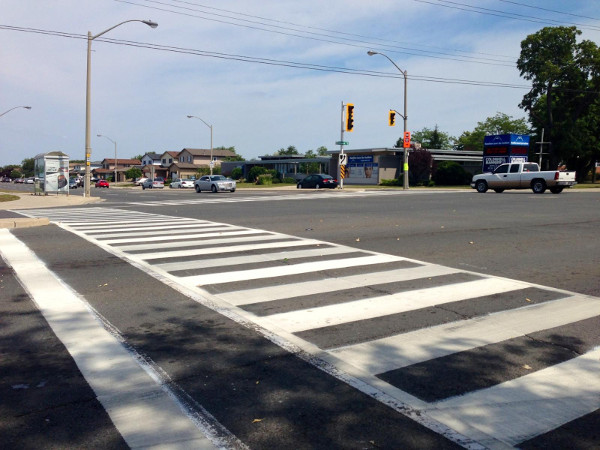
Mohawk and Upper Wentworth
The intersection of Locke and York is brutal for the very long distance pedestrians need to walk to get across York. The "pedestrian refuge" island in the middle of the boulevard is scant compensation for a light cycle that is too short for children or seniors to get across, but the new zebra crossing will at least alert motorists that pedestrians are allowed to cross.
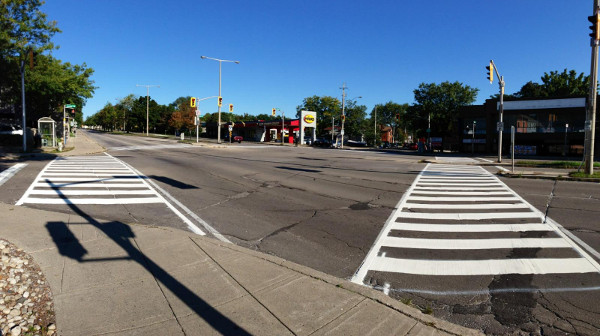
Locke and York
Locke and King has also gotten the zebra treatment:
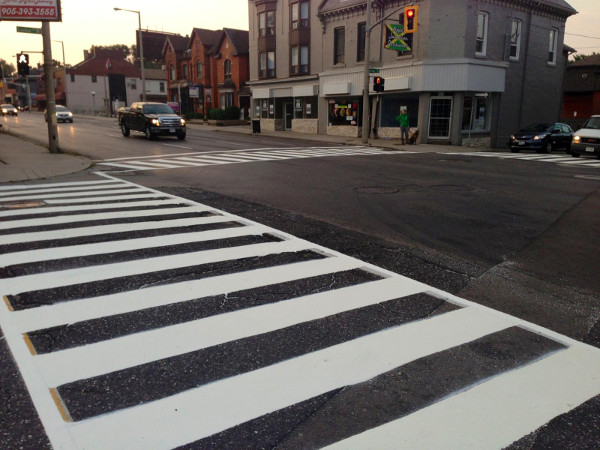
Locke and King
The zebra crossings on King near Locke even integrate nicely with the new transit lane:
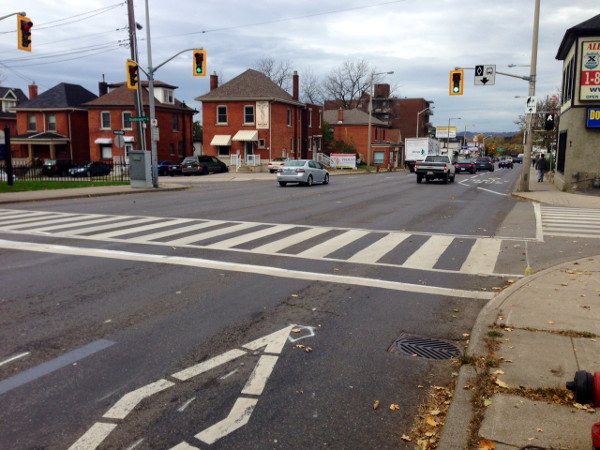
King and Strathcona with transit lane
See also:
Update: the caption for the last photo incorrectly stated that it is at King and Locke. It is actually at King and Strathcona. Thanks to the RTH reader who noticed the error.
By Shempatolla (registered) - website | Posted November 07, 2013 at 10:19:38
Good news all around except for one aspect. Speed bumps. As an emergency services worker I can say without a doubt they are not helpful. Testing done by the IAFF and major fire services and other emergency services in North America have concluded that each speed hump adds between 6 and 8 seconds to the response time of an ambulance or fire truck responding to a scene. So 10 speed bumps on a street adds 1 FULL MINUTE to a response time. This can mean the difference between someone living or dying.
There are other traffic calming measures that are as effective as bumps that don't have a corresponding effect on emergency services response times.
By seancb (registered) - website | Posted November 19, 2013 at 14:06:09 in reply to Comment 94448
That stretch of charlton should not be a through street to the 403. If Queen was two way, charlton would see a lot less traffic.
By kevlahan (registered) | Posted November 07, 2013 at 12:39:34 in reply to Comment 94448
If emergency vehicle response time is really an issue (i.e. if there is no alternative to reach a destination but take a route that requires crossing many speed bumps), the city could install "speed cushions":
http://en.wikipedia.org/wiki/File:Rubber...
http://co2calculator.files.wordpress.com...
These slow down cars, but allow wide wheel base emergency vehicles to pass unimpeded.
Of course, the argument against speed bumps can equally be made against traffic lights: emergency vehicles must slow down (even more) to go through a red light. Similar for stop signs and other traffic control devices.
Comment edited by kevlahan on 2013-11-07 12:41:00
By mikeonthemountain (registered) | Posted November 07, 2013 at 12:43:18 in reply to Comment 94488
That is what they are using in Nottingham on residential side streets. Speed cushions, not full bumps. With yield signs instead of stop signs. Thank you for the terminology clarification!
By Fred (registered) | Posted July 24, 2014 at 02:57:19 in reply to Comment 94491
Is this the sort of thing you mean... http://www.sinoconcept.com/products/traf...
Yep, definitely different to normal speed bumps!
Comment edited by Fred on 2014-07-24 02:58:14
By mikeonthemountain (registered) | Posted November 07, 2013 at 12:09:51 in reply to Comment 94448
Right now I'm in Nottingham UK, and making observations :)
Proper ring road around the city. Many roads have dedicated bus lanes, even if narrow - each direction one bus lane and one car lane. Cyclists and disability taxis are allowed to use the bus lanes. There is definitely rush hour congestion. But you can take the tram, train, or bus, all with excellent service (I got here from Manchester airport via public transit)
Speed cushions (previous I said speedbumps) are on virtually all inner neighborhood side streets. No stop signs, all yield signs - but it is very safe because you couldn't speed down a side street if you wanted to. No speed bumps at all on any main or secondary roads. Ambulances are flying around - presumably they use main roads to the closest side street.
We need to think through where we put them, but high risk crossings like Charlton and Wentworth are well suited for raised crossings (the fire truck or ambulance is slowing down for the railway tracks anyway!)
Comment edited by mikeonthemountain on 2013-11-07 12:44:17
By Pxtl (registered) - website | Posted November 07, 2013 at 10:34:55 in reply to Comment 94448
Yeah, I'm baffled by the new speed bumps on Charlton. Just make Charlton 2-way. Then traffic is rehabilitated without adding an obstacle for ambulances.
Really, this whole maze of 1-ways here:
https://maps.google.ca/maps?q=google+map...
Get rid of the whole lot of them and you've calmed the traffic in Kirkendall and Durand far more effectively than a little speed-hump would.
By lemalas (registered) | Posted November 07, 2013 at 11:08:11 in reply to Comment 94449
Greg, that's something I'd never considered before, and a valuable point. But wouldn't you agree that traffic-calming measures like these also quite literally mean the difference between someone living and dying? And it certainly decreases the number of pedestrians and cyclists hit by motorists that ESWs like yourself have to rush to save.
By Shempatolla (registered) - website | Posted November 07, 2013 at 22:10:27 in reply to Comment 94461
The problem with standard speed bumps is they don't really impede the progress of a car, but a heavy duty large wheeled vehicle going over them at any kind of speed can result in spinal injuries for everyone on board. It's more about where they are installed. And again there are traffic calming measures that are zero impact that work just as well.
I can't speak to Hamilton but in Toronto there was a stampede to put speed bumps in everywhere, with only a petition of 5 signatures on a street required to be put on the installation list. It got out of hand, there was no coordination, and I question the end result. There are areas that need traffic calming and those that don't . The goal is to properly identify them.
By KR (anonymous) | Posted November 07, 2013 at 10:46:13 in reply to Comment 94449
As someone who lives on Charlton, the speed humps are a most welcome addition - without them the Queen to Locke stretch is one long raceway with a stop sign at Kent that is ignored by many drivers. If there are other effective traffic calming measures that wouldn't slow down ambulances, I'm all for it, though I can't fathom what would slow down regular traffic but not ambulances.
Changing Charlton to two-way is a non-starter. Unless you eliminate the on-street parking, it's not wide enough for two lanes. And eliminating parking would be a disaster - there's already too little parking to service Locke St. overflow and sports teams at HAAA Park.
By jason (registered) | Posted November 07, 2013 at 10:41:44 in reply to Comment 94449
Keep in mind, many of those streets are narrow and have street parking on both sides. If we convert to two-way and lose one or both sides of parking, we will then see a pile of the mature trees and front gardens replaced with parking pads. This is illegal in TO, but the practice is alive and well in Hamilton. Our neighbourhood just saw 3 grand old trees come down the past month for mini-parking pads. All of our little side streets are two way. None have parking on both sides because there's no space. Every action has an opposite and equal reaction.
By grahamm (registered) | Posted November 07, 2013 at 11:48:00 in reply to Comment 94454
Current zoning laws actually reinforce the parking pads. Renovations to residences often trigger a site plan application which, due to increased area, triggers additional on site parking. One house in my neighbourhood was renovated and the City required an additional 2-3 spaces for a single family dwelling. Zoning by-laws need to be reviewed and brought in line with a modern vision of our City.
By Pxtl (registered) - website | Posted November 07, 2013 at 11:13:50 in reply to Comment 94454
I could see that argument maybe made for the region running past HAAA where it's narrowest, but the rest of the road? Bond Street in Westdale North is of a similar width and sports parking on both sides of the street. It's close to Churchill Park and GRAllan school, so similarities abound. Drivers have to be courteous and careful passing each other, but they manage. Through traffic would take Herkimer which is wide enough to have those cars pass comfortably, just like Westdale North does with Longwood (which bears a dividing yellow line).
Although I guess by that metric, the speed hump is by the HAAA, so yeah, go speed hump, objection withdrawn. But on the other-other-hand, if traffic throughout the neighborhood was slowed-down by 2-way traffic, the single solitary 1-way stretch past HAAA probably wouldn't see people accelerating that much. Drivers get "velocitized" from fast areas and then keep the speed often as they enter slow areas, so 1-way Charlton-by-HAAA would still fare better if it was surrounded by 2-way streets.
Comment edited by Pxtl on 2013-11-07 11:30:53
By jason (registered) | Posted November 07, 2013 at 10:44:03
Re: West Mtn gridlock. I'm there many times a week, and have been for decades. Cars rarely do less than 60k, let alone gridlock. Are we a 10-minute city, or a gridlocked Manhattan?? Can't have it both ways.
By Pxtl (registered) - website | Posted November 07, 2013 at 11:21:53 in reply to Comment 94456
To be fair, the bottlenecks do see some back-ups at rush-hour. For example, Garth gets pretty snarled up between the Linc and Limeridge, and then gets snarled up again at Fennel when Beckett Drive mountain access was open. That said, the bulk of the road was, indeed, a highway. That's the frustrating part - the trouble is obviously the bottlenecks and not the length of the road. There's no reason to protect this fast traffic because the drivers are going to have to stop and suffer some congestion when they arrive at the next bottleneck. It's like flooring it to get to a red light - it's a waste of gas and safety.
By seancb (registered) - website | Posted November 07, 2013 at 11:33:46 in reply to Comment 94466
Yes but these "snarls" represent time spent in traffic in the neighbourhood of 3-5 minutes. It's quite literally nothing worth mentioning for anyone who doesn't feel entitled to go 40-60km/hr on all streets all day
By Sleeve (anonymous) | Posted November 07, 2013 at 11:51:02
That last picture is King and Strathcona, west of King and Locke.
By seancb (registered) - website | Posted November 07, 2013 at 12:02:55
This is great stuff. Now can we get a raised crossing where the rail trail crosses wentworth near the end of charlton? Is it time yet?
By Michelle Martin (registered) - website | Posted November 07, 2013 at 20:11:43
Love those bumpouts at the Delta-- added bonus of slowing down traffic enough that, when I am driving, it is easier to make a left turn from my street, just east of the Delta, onto King St. because the drivers coming round from the Delta can't drive like they're slot cars! Safer for pedestrians=safer for motorists, too.
Now let's get some bump-outs and zebra stripes at King and Ottawa-- this is a terribly treacherous corner, my husband and daughter were almost hit walking home from her basketball game last night.
You must be logged in to comment.
There are no upcoming events right now.
Why not post one?